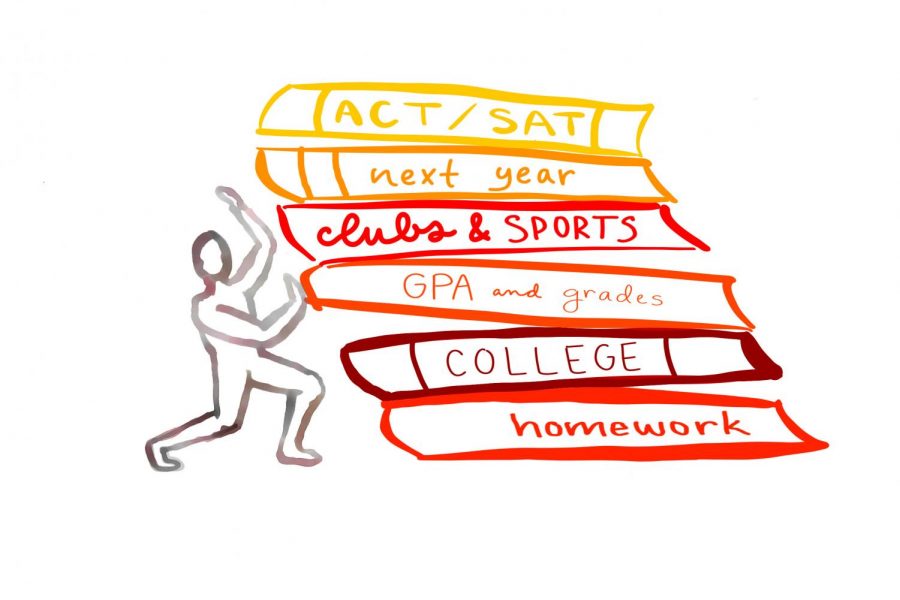Junior Burnout
“With these current stressors, it’s no wonder burnout hits many juniors like a bag of AP textbooks.”
February 14, 2020
For juniors, the future is a monstrous figure looming just over the horizon. Currently, many are facing the most difficult year of their high school careers. Transitioning into eleventh grade brings more than just heavier workloads and harder classes. Often a year filled to the brim with high-level classes and extracurriculars, the junior year of high school is when students go all in to buff their resumes. This often includes taking on leadership positions. With registering for senior year, the class of 2021 is faced with the added challenge of fitting the trimester required course Personal Finance into their schedules. They, like every junior class before them, are also tasked with choosing how they’d like to fill the rest of their schedules. Planning for, scheduling, studying for, and taking either the SAT or ACT is another burden juniors have on their plates. These tests are often crucial for getting accepted into college. The AP standardized tests are another thing many juniors have in their future, come May. With college just around the corner, juniors are edging ever closer to the daunting application process. Seniors have the excuse of senioritis, even though their stress over college is slowly coming to an end. With all of these current stressors and the uncertainty of the future, it’s no wonder burnout hits many juniors like a bag of AP textbooks.
The transition into junior year is chaotic at best. It throws unsuspecting students into the deep end with endless activity and more work than they’ve had in their past two years of high school. Yes, they may be taking a similar amount of AP classes next year, but this is the first year they’ve had this much on their plates.
One of the biggest stressors for juniors is full schedules, which mean lots of work to take home. That, in turn, means very long nights for them. Clubs or sports may keep students at school until around five to seven, sometimes even later. Morning extracurriculars, such as lifting, wake students up around six in the morning. With difficult classes and an extensive amount of homework, students are spending hours a night on math problems, chemistry equations, and essays. In school, many juniors are taking on leadership roles such as mentoring younger students and volunteering. These are often in preparation for senior year and are important additions to resumes. On top of school and extracurriculars, 16- and 17-year-old juniors are starting to work. All of this takes time away from the eight to ten hours of sleep that are recommended for teenagers.
Another stressor juniors bear is the burden of planning for their last year of high school. The requirement of Personal Finance caught many students off guard this year. Although many will be able to fit it into their schedules, others will have to drop coveted electives to squeeze this into their already busy days.
While scheduling their classes, juniors ought to consider which will benefit them the most. They have to look toward college and then past their education to how they could apply those electives to their prospective occupations. These decisions can be overwhelming, but they don’t even come close to the college selection process. College selection means location, affordability and tuition aid, size, and a plethora of other factors. These choices are not only overwhelming, but they also plague the future with ambiguity. This can cause anxiety and increased mental strain.
In the meantime, juniors have plenty to stress over in the near future. With a few ACT and SAT dates come and gone, and registration for summer tests approaching quickly, they have a lot of choices to make. From which of the tests to take, to when to take them, to whether or not to take them at all; these choices could seem completely pointless. Not only might they have a cynical viewpoint on decisions like these, but they could also not make them at all. Ignoring this critical juncture could negatively impact everything that follows. However, with burnout, it doesn’t matter because it often feels like nothing one does matters.
Juniors taking AP classes this year have increased workloads, which are often more challenging. If they feel overworked or unable to meet the continuous requirements of these classes, they may give up entirely. It would be even more difficult for them to push themselves to study for the AP tests they have signed up to take.
Many factors of burnout are also symptoms and these patterns can bring someone to feel trapped. Procrastination, for example, is a common symptom. Putting off a task or taking longer to get things done often leads to a pile-up of work, which again leads to increased stress and pressure to get everything done on time. For example, exhaustion is both a cause and an effect of it. Lack of sleep can lead to stress; if sustained, this leads to a state of emotional and physical fatigue. Similarly to teenage depression, burnout can reduce motivation in students, diminishing their overall performance academically and in all of their activities.
Burnout can also have long-term negative effects, such as increased susceptibility to diseases, clinical depression and anxiety, and suicidal thoughts. The feeling of not having enough gas in the tank to keep going is the main emotional burden of it. It may make life seem pointless or hopeless. Burnout, while caused by stress, is not the same as stress. In fact, they’re almost foils of each other. While stress causes emotions to be hyperactive, burnout dulls emotions into depression. Both are serious. Stress at the extreme can lead to anxiety and anxiety disorders which in turn shortens life expectancy. Burnout can lead to cynical, even suicidal, thoughts; effectively turns off the light at the end of the tunnel, removing purpose from life.
Not unlike someone with depression, people suffering from burnout may find it difficult to express how they feel. However, the most common symptoms in teenagers are often connected with school. Homework and assignments may feel overwhelming, in-class work may seem dull, participation may seem pointless or unappreciated, etc. Even after completing a task that may seem at best uninteresting, a student with burnout is likely to feel no sense of accomplishment.
All of these burdensome symptoms also spill into other aspects of life. A sense of detachment from family and friends or just the general weight of loneliness are common emotional symptoms of burnout.
However, one of the best ways of combating burnout is by connecting with people who make you happy. Limiting your interactions with negative people or people who make you feel bad can also relieve some of the stressors that are causing you to burn out. Communicating with bosses, teachers, or other people you trust can benefit both you and other people in those stressful environments. Teachers can try and understand the stress loads of these juniors and do their best to help them cope. There already have been multiple improvements, such as AP Capstone’s Mindfulness Wednesdays and mandatory advisory. Teachers need to take into consideration the homework from other classes and extracurricular activities when assigning their own work. City High can find other ways to support students who feel weighed down by their junior year. However, the important thing for juniors to remember is that there are about three hundred other students in the same boat, and generations of juniors before them have managed to survive.
































